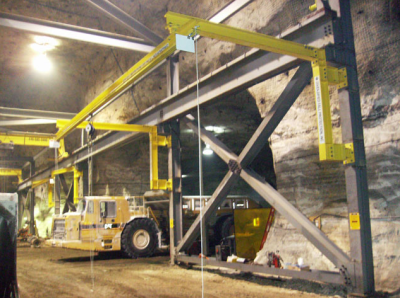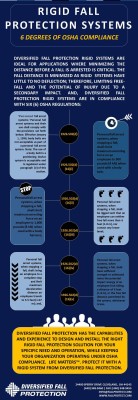When you hear the phrase “fall protection”, your mind probably gravitates towards the highest points in your facility. For some, this location is the rooftop or a shop crane rail while others may have a mental picture of a tall piece of equipment or an elevated work station. All these plant locations are potential candidates for a fall arrest system but did you know the basic principles of fall protection also apply to mine applications? This post strays a bit from our typical Tech Talk fare, exploring how we apply our knowledge of fall protection to protect miners working hundreds and even thousands of feet beneath the earth’s surface.
It might seem counter-intuitive, but fall protection is just as important in underground mining applications as maintenance, inspection, repair, and construction activities above ground. With this said, there are some basic differences between mining and more traditional fall protection applications. One of the first main differences involves regulatory agencies; OSHA oversees industrial and construction sites while MSHA (The Mine Safety and Health Administration) is the safety watchdog for the mining industry. Although there is a good deal of consistency between OSHA and MSHA fall protection regulations, MSHA regulations and reporting standards are more stringent. Both OSHA and MSHA require fall protection for personnel working at heights greater than 4 feet, but MSHA is more particular about how we implement, inspect, and re-certify a fall protection solution.
Our work for a nationally known company that engages in salt mining is case in point. Large material handling vehicles used to transport the salt throughout the mine require periodic maintenance that poses a fall hazard for mine personnel. For this application, we used an articulating rigid beam fall arrest solution, which is ideal for low fall clearance distance applications. Rigid systems minimize deflection and arrest a fall within 1-2 feet. The other obvious advantage to this style of fall arrest system is the space-saving design. When not in use, the system folds up, allowing large equipment to pass freely through the work area.
One of the main concerns with mining applications is suitable anchorage. From a design perspective, we need to exercise great care that forces exerted in the event of a fall do not cause a ceiling collapse. The other obvious design concern here is corrosion. The presence of water and salt creates a corrosive environment that can cause a fall arrest system to wear prematurely or fail. The system shown above features hot-dipped galvanized steel structural members painted with a special coating to resist corrosion. In addition, we use stainless steel for the track’s critical moving parts to extend service life.
The mine’s maintenance staff includes expert mechanics with the skill set needed to disassemble heavy equipment for transport down into the mine and then re-assemble the vehicles for use. That said, they turn to DFP safety engineers for inspection, maintenance, and bi-annual certification of the fall arrest equipment to ensure full compliance with MSHA regulations and standards. One of the most important issues with any of our fall arrest systems is liability. Diversified Fall Protection is a turnkey provider of engineered fall arrest systems. As a single source provider responsible for the design, installation, maintenance, inspection, and re-certification of the mine’s fall arrest equipment, we assume liability for the system.
Fall arrest systems for mining applications present a number of design challenges that increase the complexity of implementing fall protection solutions to keep workers safe. Our knowledge of the nuances of MSHA’s fall protection standards combined with our years of experience in the mining market sector makes Diversified Fall Protection an ideal candidate for your next project. If you have questions about fall protection systems for mining applications or wish to discuss your specific fall arrest needs, contact Diversified Fall Protection for further assistance.
Did you know……
All of Diversified Fall Protection’s Rigid Beam Fall Arrest Systems are designed and manufactured to ensure 7 Degrees of OSHA Compliance?
Additional MSHA and mining safety considerations:
- The frequency of inspection is higher with MSHA than OSHA–typically 4 times per year underground and 2 times per year above ground.
- Underground safety becomes a consideration with MSHA that OSHA doesn’t deal with.
- Rescue and Retrieval of individuals from underground adds another chain in the emergency response process as typical EMS and firefighter personnel have limited access to mines.
- Respiration Testing and use is more frequent for underground.



